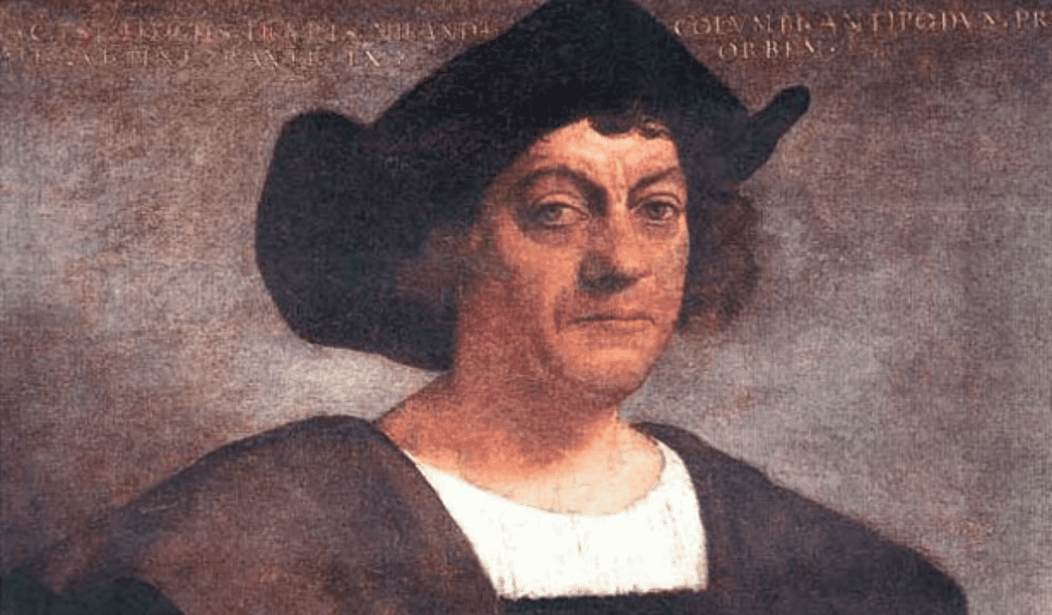While this article was originally published last year, it is extremely relevant for America today and for Columbus Day 2020.
This month, Washington, D.C. — which is literally named after Christopher Columbus — voted to abolish the celebration of Columbus Day. Alaska, Hawaii, Maine, New Mexico, South Dakota, and Vermont do not celebrate Columbus Day, either. These states struck down the holiday in favor of Indigenous Peoples’ Day, which the U.N. celebrates on August 9.
Here are 5 reasons to celebrate Columbus Day on October 14, and to leave Indigenous Peoples’ Day on August 9 where it belongs. Contrary to popular belief, Columbus Day is a celebration of diversity, not oppression.
1. The war against the Western heritage.
The attack on Columbus Day is a major facet of the cultural onslaught against the Western heritage behind the freedom and success of the United States of America. As the Daily Signal’s Jarrett Stepman noted, far-left historian Howard Zinn pushed the crusade against Columbus as part of an attack on America’s broader heritage.
“It wasn’t just Columbus who was a monster, according to Zinn, it was the driving ethos of the civilization that ultimately developed in the wake of his discovery: the United States,” Stepman noted. He quoted Zinn:
“Behind the English invasion of North America,” Zinn wrote, “behind their massacre of Indians, their deception, their brutality, was that special powerful drive born in civilizations based on private profit.”
Yet the free market system of “private profit” Zinn so maligns has created wealth at a scale unimaginable to most humans throughout history. Inventions like the microwave, the refrigerator, the television, the automobile, aircraft, and the iPhone have enabled the easy preservation and cooking of food, the speedy transportation of all kinds of goods across the world, and the dissemination of information and entertainment at a scale our ancestors would never have dreamed of.
Private property was also one of the fundamental rights advocated by John Locke, and an early draft of the Declaration of Independence may have hailed the rights to “life, liberty, and property,” before it became the more poetic “pursuit of happiness.”
The American system of limited government is far from perfect, but it has fostered entrepreneurship and individual freedom. The values in the Declaration of Independence were in direct conflict with the horrific institution of slavery, and those values helped spark movements to eradicate slavery. The Founders sought to restrain slavery from expanding into the territories, and the South precipitated the Civil War by pushing the expansion of slavery against the Founders’ intent.
Americans should appreciate their rich heritage, rather than demonizing their history. Liberal historians and publications like The New York Times are wrong to reinterpret American history by placing the evils of slavery at the center. Americans must understand the evils of the past, but they should also be grateful for the values that inspired the ultimate rejection of slavery and the expansion of voting rights to minorities and women.
2. A historic discovery.
Many claim that Columbus did not “discover” the Americas — either because the indigenous people who crossed the Bering Strait did so first or because Leif Erikson was the first European to do so. Columbus may not have been the first, but his discovery connected the Americas to Europe and Asia and his discovery also expanded the field of human knowledge.
Contrary to popular belief, medieval scholars did not think the Earth was flat. Since the ancient Greeks, scholars knew the Earth was round. In fact, Eratosthenes of Cyrene in the 3rd century B.C. had correctly computed the circumference of the Earth by using simple geography and studying the shadows cast by objects at remote locations. Ancient measurements were known among scholars, but confusion over old-fashioned units of distance led to debate about the size of the Earth.
Columbus thought the Earth was much smaller than it truly was, so he provisioned ships for a long journey, expecting to land in Asia. His measurements were off, and were there really nothing but ocean between Europe and Asia, he and his crews would have died of thirst or starvation long before reaching the East Indies. The discovery of the Americas proved the ancients correct in their larger estimates of the circumference of the Earth, adding to scientific knowledge.
3. The merging of two worlds.
In addition to expanding human knowledge, Columbus connected two worlds. In the “Columbian Exchange,” crops that only grew in the Americas became available in Europe and Asia, while the Europeans introduced livestock, writing systems, and new crops like coffee and sugar to the Americas.
It is true that that Columbian Exchange also involved the enslavement of native Americans and the introduction of Old World diseases that decimated native populations. These evils must be acknowledged, and historians should also acknowledge that the Americas introduced new diseases to Europeans, as well. Even so, the Columbian Exchange also introduced long-term benefits to both the Americas and Eurasia.
Before Columbus, potatoes, corn, tomatoes, and tobacco only grew in the Americas. Potatoes helped Europeans stave off hunger, and they also spread as far as India. In the 1500s, Spanish colonizers introduced corn and sweet potatoes to Asia, resulting in population growth. Pizza was not invented until the 1800s!
Europeans also introduced many new crops to the Americas, including almonds, bananas, carrots, cinnamon, citrus, coffee, garlic, oats, olives, peach, peaches, pistachios, and wheat. Some of these crops helped natives fend off food scarcity and starvation. Livestock like cattle, pigs, sheep, and horses were also introduced, allowing for a more meat-heavy diet.
While writing developed independently in Mesoamerica, the grand Inca Empire of Peru and many other Native American tribes did not have written languages. The Europeans exploited this weakness, but they also introduced writing to these unlettered people.
Europeans also introduced new technologies like the compass, the navigational map, and new forms of crop rotation.
The merging of the two worlds had negative consequences, but it also brought long-term benefits which people around the world now enjoy.
4. History is complicated.
Historians like Howard Zinn have demonized Columbus and the Western heritage, but the story of Columbus’s evils is far from neat or clear.
As Aileen Riotto Sirey, founder of the National Organization of Italian Women, and Angelo Vivolo, president of the Columbus Heritage Coalition, noted in an article for the New York Post, slavery was already in America before Columbus landed. “So were cannibalism and human sacrifice, neither tolerated in the Old World,” they noted. The great pre-Columbian American empires sacrificed enemies captured in war and even their own children. Some ate the flesh of enemies to take their strength.
Columbus aimed to introduce the value system that eradicated human sacrifice in Europe — Christianity. In fact, according to sociologist Robert Woodberry, the missionary spread of Christianity has promoted democratic values across the world.
In fact, the brand of Catholic Christianity Columbus aimed to spread to the New World also condemned the abuse of Native Americans. The Spanish School of Salamanca helped lay the framework for international law, and scholastics like Domingo de Soto argued that Native Americans had human rights equal to those of Europeans, and condemned their enslavement. These scholars condemned the Catholic monarchs for allowing such abuse and enslavement.
Columbus aimed to extend Christianity to regions where it did not exist. “This conviction that God destined him to be an instrument for spreading the faith was far more potent than the desire to win glory, wealth, and worldly honors,” according to historian Samuel Eliot Morison.
Historian Carol Delaney also debunked claims that Columbus supported genocide. “Columbus strictly told the crew not to do things like maraud, or rape, and instead to treat the native people with respect,” she told the Knights of Columbus. “There are many examples in his writings where he gave instructions to this effect. Most of the time when injustices occurred, Columbus wasn’t even there. There were terrible diseases that got communicated to the natives, but he can’t be blamed for that.”
Interestingly, Columbus also adopted an indigenous child as his son.
Columbus was far from perfect, but he was also not the villain oft portrayed today. Many wrongly demonize him as the scapegoat for the evils of European colonialism and slavery in the Americas. This simple view must be rejected.
5. The Ku Klux Klan and Italian-American heritage.
Much of the demonization of Columbus traces back to an anti-Catholic anti-Italian prejudice that led the Ku Klux Klan and other groups to demonize the Italian explorer. The celebration of Columbus Day actually helped American diversity, integrating this Italian-American hero into America’s pantheon and encouraging acceptance of Italian-Americans.
“Columbus has been a target of white supremacists since the 1920s, when a resurgent Ku Klux Klan attacked monuments and celebrations of Columbus from coast to coast,” Patrick Korten, a member of the National Christopher Columbus Association (NCCA) board of directors, said in 2017.
“They hated that he was Mediterranean not Anglo, that he sailed for Spain, not England, that he was popular in the immigrant community, and most of all, that he was Catholic,” Korten added, noting that “Catholics, along with African Americans and Jews, were regular targets of the Klan.”
The NCCA board member warned that “the disparagement of Columbus today has its roots in a centuries-old habit of painting Italian and Hispanic immigrants in this country as cruel, violent, sexually aggressive and untrustworthy. In the context of Spanish exploration, this is known as the ‘Black Legend’ — based on propaganda peddled about Spain dating from the 16th century, which continues to be the grist for racially tinged comments about Hispanics and Italians to this day.”
As Sirren and Vivolo noted in their New York Post article, one of the catalysts for Columbus Day came on March 14, 1891, when an angry New Orleans mob lynched 11 Italian immigrants after they were cleared of murder charges.
Columbus Day helped Americans recognize Italian immigrants as their fellow Americans — with a noble heritage.
Columbus Day is not a symbol of oppression, but a symbol of American pluralism, the acceptance of a new influx of Americans from Columbus’ native Italy. Just as the 13th Amendment corrected a historic American evil by abolishing slavery, so this holiday helped combat the anti-Italian prejudice behind a horrific lynching.
So raise a glass of Prosecco and celebrate the Italian adventurer.
Tyler O’Neil is the author of Making Hate Pay: The Corruption of the Southern Poverty Law Center. Follow him on Twitter at @Tyler2ONeil.









Join the conversation as a VIP Member